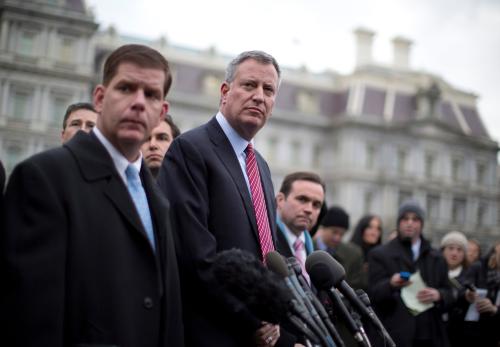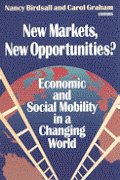Social mobility is a hot topic this summer. A major new study by Harvard’s Raj Chetty and colleagues has shown powerful effects of place on life chances, with children from similar backgrounds in, say, Atlanta and New York having sharply different odds of doing better than their parents on the income scale.
President Obama has also given a speech and an in-depth interview on the theme of building an opportunity society. “We are not a people who allow chance of birth to decide life’s big winners and losers,” he declared. Obama also described the reduction in opportunities for upward mobility as “a betrayal of the American idea.”
Stripped of political rhetoric, the president’s speech contained three important goals: strengthening the middle class; expanding the middle class; and opening up the middle class. These are quite distinct, not least in terms of policy.
A “stronger middle class” is short-hand for improved economic circumstances and security for working Americans. Obama evoked a “basic bargain” for the middle class, in which “hard work would be rewarded with fair wages and benefits, the chance to buy a home, to save for retirement, and, above all, to hand down a better life for your kids.”
So: higher wages and pensions; lower costs for health care and college; and a better chance of owning a home. Here the policy agenda covers improved high school education; better worker training; a higher minimum wage, lower interest rates on student debt; the Affordable Care Act; more accessible tax breaks for retirement savings; and mortgage refinancing opportunities. In short, making life a bit easier and bit better for ordinary working Americans.
But the last clause in the president’s social contract is intergenerational: the chance to “hand down a better life for your kids.” The most effective way to ensure each generation does better than the last is to grow the economy, and in the process to expand the middle class. By simply making the middle class bigger over time, a higher proportion of Americans can enjoy a middle class lifestyle.
The U.S. economy has historically been very effective at creating this kind intergenerational uplift – or absolute mobility. The question is whether, post-recession, this upwards escalator is slowing down. People are certainly afraid that it is: according to surveys by the Pew Charitable Trusts, for the first time ever, a minority of U.S. citizens now think their children will be better off than themselves. This is the anxiety the president addressed.
In terms of growing the middle class, the key policy themes here are education, infrastructure and technology. We need economic growth—and specifically, growth that creates more middle class jobs. Obama also took aim at the lopsided nature of recent economic progress, with the richest taking a higher share of the proceeds of growth than middle-income workers. Here, though, the administration, hamstrung by Republican congressional forces, has little to offer beyond existing measures to make the tax system modestly fairer.
But the most challenging item on the president’s agenda was the third: opening up the middle class. Here, the implicit goal is to improve relative social mobility; not just to increase the number of people doing better than their parents, but to weaken the link between the class a person is born into and the class position they occupy as an adult.
Obama recognized that this goal was distinct from the broader economic goals of strengthening and expanding the middle class: “As we work to strengthen these cornerstones of middle-class security, I’m going to make the case for why we need to rebuild ladders of opportunity for all those Americans still trapped in poverty. Here in America, we’ve never guaranteed success. More than some other countries, we expect people to be self-reliant, and we’ve tolerated a little more inequality for the sake of a more dynamic, more adaptable economy. But that’s always been combined with a commitment to upward mobility—the idea that no matter how poor you started, you can make it with hard work and discipline…that’s why we have to do a lot more to give every American the chance to work their way into the middle class.”
The U.S. suffers from lower levels of relative social mobility than other comparable nations. In particular, the American income distribution has a ‘”sticky bottom”: in other words, people born poor are more likely to remain poor as adults. Forty-two percent of U.S. adults born into the bottom fifth of the income distribution remain there as adults, compared to 25% in Denmark and 30% in the UK.
While the first two of the president’s goals—strengthening and expanding the middle class—rely mainly on successful economic policy, the third—opening up the middle class by promoting upward intergenerational relative mobility—is principally a social policy challenge. The cornerstones of a concerted effort to improve relative mobility are:
First, supporting successful family formation and parenting. Having kids later in life, in a stable relationship, and with a degree of economic security makes a world of difference to life chances. Good parenting also matters for mobility, as forthcoming research from the Center on Children and Families demonstrates. There are well-evaluated parenting programs, including Nurse Family Partnership and HIPPY, that can help struggling parents do a better job. Misplaced concerns about a “nanny state” should not prevent greater investment in the army of pre-K educators currently deployed in the U.S.: parents.
Second, ensuring wider access to formal high-quality pre-K education. The administration’s drive to support pre-K for poorer families is squarely aimed at closing the opportunity gap that opens up before children get on the first bus to elementary school. There are legitimate concerns about quality assurance, especially following disappointing evaluations of Head Start. Poor-quality pre-K education should be called what it really is: childcare. This has real value in terms of labor market opportunities for parents, especially single moms—but not for improving the educational prospects of their children. An opportunity agenda demands quality pre-K, not childcare.
Third, reforms to school financing and governance aimed explicitly at closing the gap between the worst and best schools. Many of the current initiatives, including Race to the Top, have this goal. These programs would be improved by an additional emphasis on non-cognitive skills—in other words, character—alongside the current focus on cognitive test scores. But in the longer-term, reforms to the skewed U.S. school financing system will also be required.
Last, but not least, greater efforts must be made to open up higher education—especially elite colleges—to poorer teenagers. College remains a ticket to the middle class. But too few poorer young people make the journey. Containing the cost of student debt is important for reducing the cost of living for graduates: but that is not the main obstacle for entering college in the first place. There are cost-effective ways to increase application rates to good colleges from bright, poor kids, as a recent Hamilton Project report makes clear.
Crucially, in all these areas the central policy goal is not to raise overall standards—important though that is for other reasons—but to close the gap between those born into poor and non-poor households.
We need a stronger, bigger middle class. But we need a more open middle class too: one into which more of our poorest children can climb. Economic growth alone won’t automatically build ladders from poverty into the middle class. Concerted, consistent social policy intervention is also required. The president sounds convinced. But is he convincing enough to win over his political opponents? Let’s hope so.










Commentary
Opening up the Middle Class
August 1, 2013